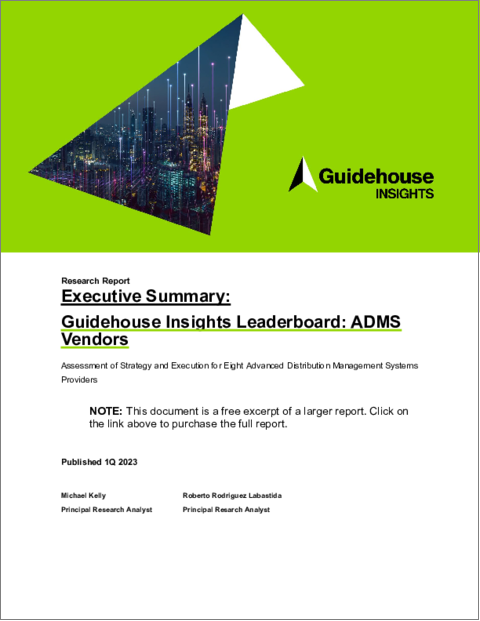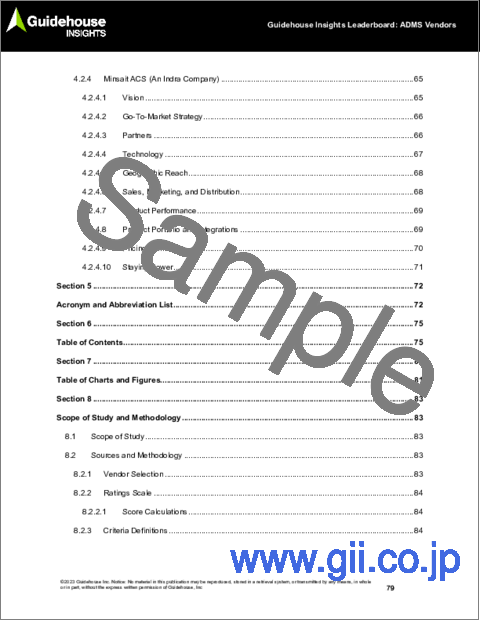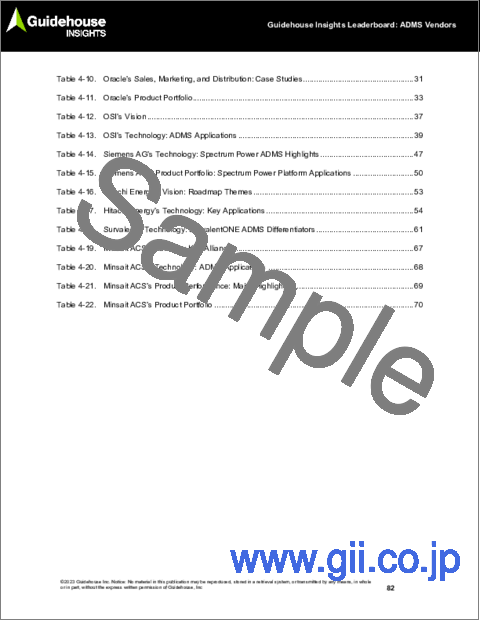|
|
市場調査レポート
商品コード
1211702
ADMSベンダー:先進的流通管理システムプロバイダー8社の戦略と実行力の評価Guidehouse Insights Leaderboard Report - ADMS Vendors: Assessment of Strategy and Execution for Eight Advanced Distribution Management Systems Providers |
||||||
| ADMSベンダー:先進的流通管理システムプロバイダー8社の戦略と実行力の評価 |
|
出版日: 2023年02月06日
発行: Guidehouse Insights
ページ情報: 英文 86 Pages; 38 Tables, Charts & Figures
納期: 即納可能
|
- 全表示
- 概要
- 目次
当レポートでは、ADMSベンダーついて調査し、先進的流通管理システムプロバイダー8社のプロファイル、戦略および評価などの情報を提供しています。
目次
第1章 エグゼクティブサマリー
- イントロダクション
- リーダーボードグリッド
第2章 市場概要
- 市場の定義
- 市場促進要因
- 市場の障壁
第3章 リーダーボード
- リーダーボードカテゴリー
- リーダー
- コンテンダー
- チャレンジャー
- フォロワー
- リーダーボードグリッド
第4章 企業ランキング
- リーダー
- Schneider Electric SE
- General Electric
- Oracle Corporation
- Open Systems International, Inc.
- コンテンダー
- Siemens AG
- Hitachi Energy
- Survalent Technology
- Minsait ACS(An Indra Company)
第5章 頭字語と略語のリスト
第6章 目次
第7章 図表
第8章 調査範囲と調査手法
- 調査範囲
- 情報源・調査手法
- ベンダーの選択
- 評価スケール
- 基準の定義
Distribution management systems (DMSs) have been around for more than a decade, initially deployed to analyze power flows, optimize grid management, and support automation. However, utilities that deployed DMSs noted several redundancies associated with supporting different systems (e.g., outage management systems [OMSs] and SCADA) that relied on a model of the distribution network, but maintained separate and therefore incomplete models-requiring tiresome updates and cross-verification of data and effectively slowing both processes. This led to the evolution of the modular, advanced DMS, or ADMS.
Many vendors and utilities consider ADMSs to be a combination of SCADA, a DMS, and an OMS. This integrated architecture has grown in recent years to include EMS and DERMS modules, though this is not universal across vendors. This growth is a natural technological extension of ADMSs. The boundary between networks is becoming blurred, and future network operators require access to both transmission and distribution applications. The competitive landscape for ADMS is unique given the extensive requirements and growing list of modules captured under the ADMS umbrella. This has led to a smaller, more refined pool of vendors made up of traditional, large conglomerates (GE Digital, Schneider Electric SE, Siemens AG, Oracle, and Hitachi Energy) and smaller, more nimble vendors (Open Systems International, Inc. [OSI], Survalent, and Minsait ACS). All are making inroads in managed services and cooperative and public utility targeting. Ultimately, the selection of an ADMS vendor depends on a utility's business objectives and constraints.
This Guidehouse Insights Leaderboard compares eight ADMS vendors using ten criteria: Vision, Go-to-Market Strategy, Partners, Technology, Geographic Reach, Sales & Marketing, Product Performance, Product Portfolio & Integrations, Pricing, and Staying Power.
Table of Contents
1. Executive Summary
- 1.1 Introduction
- 1.2 Leaderboard Grid
2. Market Overview
- 2.1 Market Definition
- 2.2 Market Drivers
- 2.3 Market Barriers
3. The Guidehouse Insights Leaderboard
- 3.1 The Guidehouse Insights Leaderboard Categories
- 3.1.1 Leaders
- 3.1.2 Contenders
- 3.1.3 Challengers
- 3.1.4 Followers
- 3.2 The Guidehouse Insights Leaderboard Grid
4. Company Rankings
- 4.1 Leaders
- 4.1.1 Schneider Electric SE
- 4.1.1.1 Vision
- 4.1.1.2 Go-To-Market Strategy
- 4.1.1.3 Partners
- 4.1.1.4 Technology
- 4.1.1.5 Geographic Reach
- 4.1.1.6 Sales, Marketing, and Distribution
- 4.1.1.7 Product Performance
- 4.1.1.8 Product Portfolio and Integrations
- 4.1.1.9 Pricing
- 4.1.1.10 Staying Power
- 4.1.2 General Electric
- 4.1.2.1 Vision
- 4.1.2.2 Go-To-Market
- 4.1.2.3 Partners
- 4.1.2.4 Technology
- 4.1.2.5 Geographic Reach
- 4.1.2.6 Sales, Marketing, and Distribution
- 4.1.2.7 Product Performance
- 4.1.2.8 Product Portfolio and Integrations
- 4.1.2.9 Pricing
- 4.1.2.10 Staying Power
- 4.1.3 Oracle Corporation
- 4.1.3.1 Vision
- 4.1.3.2 Go-To-Market Strategy
- 4.1.3.3 Partners
- 4.1.3.4 Technology
- 4.1.3.5 Geographic Reach
- 4.1.3.6 Sales, Marketing, and Distribution
- 4.1.3.7 Product Performance
- 4.1.3.8 Product Portfolio and Integrations
- 4.1.3.9 Pricing
- 4.1.3.10 Staying Power
- 4.1.4 Open Systems International, Inc.
- 4.1.4.1 Vision
- 4.1.4.2 Go-To-Market Strategy
- 4.1.4.3 Partners
- 4.1.4.4 Technology
- 4.1.4.5 Geographic Reach
- 4.1.4.6 Sales, Marketing, and Distribution
- 4.1.4.7 Product Performance
- 4.1.4.8 Product Portfolio and Integrations
- 4.1.4.9 Pricing
- 4.1.4.10 Staying Power
- 4.1.1 Schneider Electric SE
- 4.2 Contenders
- 4.2.1 Siemens AG
- 4.2.1.1 Vision
- 4.2.1.2 Go-To-Market Strategy
- 4.2.1.3 Partners
- 4.2.1.4 Technology
- 4.2.1.5 Geographic Reach
- 4.2.1.6 Sales, Marketing, and Distribution
- 4.2.1.7 Product Performance
- 4.2.1.8 Product Portfolio and Integrations
- 4.2.1.9 Pricing
- 4.2.1.10 Staying Power
- 4.2.2 Hitachi Energy
- 4.2.2.1 Vision
- 4.2.2.2 Go-To-Market Strategy
- 4.2.2.3 Partners
- 4.2.2.4 Technology
- 4.2.2.5 Geographic Reach
- 4.2.2.6 Sales, Marketing, and Distribution
- 4.2.2.7 Product Performance
- 4.2.2.8 Product Portfolio and Integrations
- 4.2.2.9 Pricing
- 4.2.2.10 Staying Power
- 4.2.3 Survalent Technology
- 4.2.3.1 Vision
- 4.2.3.2 Go-To-Market Strategy
- 4.2.3.3 Partners
- 4.2.3.4 Technology
- 4.2.3.5 Geographic Reach
- 4.2.3.6 Sales, Marketing, and Distribution
- 4.2.3.7 Product Performance
- 4.2.3.8 Product Portfolio and Integrations
- 4.2.3.9 Pricing
- 4.2.3.10 Staying Power
- 4.2.4 Minsait ACS (An Indra Company)
- 4.2.4.1 Vision
- 4.2.4.2 Go-To-Market Strategy
- 4.2.4.3 Partners
- 4.2.4.4 Technology
- 4.2.4.5 Geographic Reach
- 4.2.4.6 Sales, Marketing, and Distribution
- 4.2.4.7 Product Performance
- 4.2.4.8 Product Portfolio and Integrations
- 4.2.4.9 Pricing
- 4.2.4.10 Staying Power
- 4.2.1 Siemens AG
5. Acronym and Abbreviation List
6. Table of Contents
7. Table of Charts and Figures
8. Scope of Study and Methodology
- 8.1 Scope of Study
- 8.2 Sources and Methodology
- 8.2.1 Vendor Selection
- 8.2.2 Ratings Scale
- 8.2.2.1 Score Calculations
- 8.2.3 Criteria Definitions
- 8.2.3.1 Strategy
- 8.2.3.2 Execution




